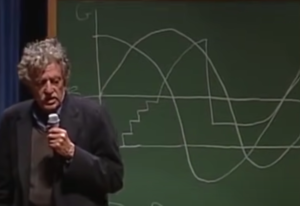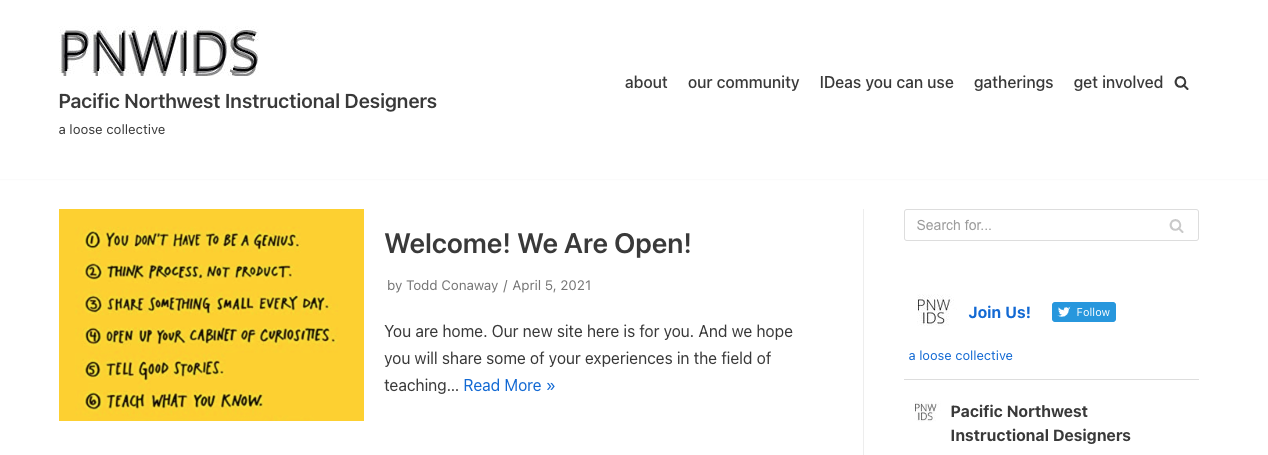QM Instructional Designers’ Learning Exchange
First, a heartfelt thank you to the QM people who have kept me close to the community. Early on it was Brenda Boyd, Steven Crawford, Melody Buckner, and JJ Johnson. Thank you for helping me introduce so many faculty to Quality Matters!
I stole this idea from Kurt Vonnegut. For me, he always told me beautiful stories and observed how nice everything really is even as he was tossed in the muddy ditch of human suffering. Yeah, so it goes.
This “shape of” idea comes from his talk at the Case College Scholars Program in 2004. Perhaps like his title, this idea should be “The Shape of Communities” because like stories, they have different paths. Either way, this is all very nice. Thank you Kurt.

Our purpose for today is as follows: We will try to identify qualities that make a learning communities successful and identify ways we can create more participation in our communities of practice. I will share with you my experiences in several unique and innovative learning communities. My hope is that you take away some wonder and interest in the kinds of communities around us and that you might create and feel empowered to begin creating them, if you have not already. Finally, we will observe how the spaces, both physical and digital, can be used to bring us together.
I asked a few people about communities and here is what they shared. If you’d like to add something, go ahead right here.
Big Questions?
- How long does a community last?
- Where do they meet?
- Who is in charge?
- Is there a product to be created?
- How do you know it is working?
- Will the world be better off as a result?
- Will you be better off as a result?
- Are these the right questions?
Qualities of an Amazing Community?

The Program for Online Teaching
This was one of the first communities I bumped into that was made up of people I did not know. I don’t recall how I came to know Lisa Lane, but wow, was I ever fortunate to meet her. To this day she is one of my most inspirational mentors. The community began in a small community college in California, but when I started to meet with them it had grown to include faculty and staff from all over the US and abroad. During the time I was most active we consistently had members join us from other countries. And this was all way before Zoom 🙂
Qualities of this Community
- Frequent interactions via the web and face-to-face – Newsletters 🙂
- Everything was new – timely topics
- Immediate relevancy to work
The Places & Spaces
Lisa Lane’s Amazing Archive of everything ever!
In 2013 we recorded come of our video conferences.
2012 Newsletter from Lisa offering a look at the work of a colleague of mine in Arizona. What a world.
Because I can add it here, because I am the boss, here is Insidious Pedagogy by Lisa Lane.

The CyberSalon
This community based in Phoenix, Arizona met once a month for many years at a bar/restaurant to discuss teaching and technology. There were rarely any scripted agendas and the community and the conversations ranged widely. To this day, I am inspired by the amazing work the people in this community have contributed to the world of education and beyond. Literally beyond in the case of Sian Proctor.
Qualities of this Community
- Informal – easy to access
- Fun
- Fun
- Meaningful friendships with participants
The Places & Spaces
Here is a wonderful poster for a conference presentation about the CyberSalon
Conference presentation that has the most amazing words
You can see the old website the community used for a few years here on the Wayback machine

The 9x9x25 Challenge
The 9x9x25 Challenge was created in response to a dire lack of easily accessible thoughts about teaching by the amazing faculty at a small community college in Arizona. My colleagues and I realized that we had amazing faculty doing amazing things. But, nowhere on the web was any mention of them. Like most faculty, when they were asked to share the good work they were doing in the classroom, they replied, “I don’t do anything special.” We called BS! Yes you do! And sometimes when they wrote for our community, the writing travelled to other spaces!
So we challenged the faculty to share some writing about the work they were doing in their classes. We told them that if they wrote 25 sentences each week for nine weeks we would reward them! We gave them a pint of Ben and Jerry’s the first week. We gave the books about learning, swag from various vendors, hand-made pots form the ceramics faculty. Houseplants from Horticulture! It was wonderful.
The writing they completed each week was shared in an email to all faculty on campus. It has been amazing for ten years. This was a great idea for a topic one year! A faculty handbook!
Qualities of this Community
- 10 to 20 faculty each year – and still going
- Highly organized, and still loose with opportunity
- Visible to the community at large
The Places & Spaces
In context of the space of the web. I am proud of this.
An old conference site with some broken examples from other institutions and memorabilia
You can see all of the 2013 posts in an interactive pdf here
And all the 2014 posts as same here
Epiphanies from the Field
This began as a formal and funded learning community at the Bothell campus of the University of Washington. The first few years we had some professional development funds and we did many of the things that a learning community might do. We read articles. Watched videos. Read and discussed books. Played with tools. We had a solid core group of five or so for a few years and always met in person. Then COVID hit and things went to Zoom. We persisted and the core group remained stedfast.
Last year we had this idea. What if each month we invited amazing people in the field of teaching and learning to share an epiphany with us around a digital campfire? Well, we did.
Qualities of this Community
- easy to access – Zoom
- Well respected guests
- Visible to the community at large
The Places & Spaces
Current location of this campfire

DS106
The ds106 community grew out of an online course delivered from the University of Mary Washington by Jim Groom. He invited others to attend the class, sort of opening it up to the public, and a number of people jumped in. They are still jumping in like 12 years later.
Hugs.
“…open online courses are not about scale and efficiency. They are about imagination and anarchy.” @jimgroom
— Todd Conaway (@Todd_Conaway) October 12, 2022
I am pretty excited about the class. I have shirts and I my car license plate is ds106 and anytime I see a 106, I stop.
For my friend @cogdog who always makes the time to take time to share great things. I am learning. #double #ds106 pic.twitter.com/KOgHKUtDay
— Todd Conaway (@Todd_Conaway) August 10, 2017
Qualities of this Community
- Art
- Themes and the amazing Daily Create
- Back when Open was really awesome!
The Places & Spaces

The Burgeron’s
Once upon a time…
Well, we had been telling various stories in the Digital Story Class #ds106, but we wondered, “Could we tell a communal story?” We wondered if we could generate a story together in a shared space. How would that work? What would the story be about? I offered it up to the larger community and we sort of broke away from them and told our own story. It was about a family in Bovine. Texas. Nothing was true…
Qualities of this Community
- Lasted for about 4 years
- Loosely tied into the ds106 community
- Very playful and exploratory
The Places & Spaces
It is a free WordPress site with 16 administrators.
Tied into the ds106 community
Very playful and a very good story of community
Well, Todd, What is the Shape of Community?
My best guess comes from the wonderful Martin Hawksey and it has no place really, no boundries or rules. No entry fee or location. And the shape moves as the community evolves. Here it is.
But Todd, Tell Us About Your Failure!
Well, this is the thing. We can create communities out of people and space and topics. We have seen that happen. But what if you want to create a community and you find it challenging. Too many things to do. Well, I did that. Here is it.

Other Failures & The Story of The Number Three
WHAT CAN YOU DO ON YOUR CAMPUS?
Great question. You don’t really need the permission or institutional structure to begin a “community.” Sure, that might help, but it is not necessary. Maybe you already have some kind of community around you that is informal. Can you build on that? Should you?
As Kurt asks us, “Can you notice when you are happy, and exclaim or murmur or think at some point, ‘If this isn’t nice, I don’t know what is.’” Maybe that is the community we are looking for? Maybe it has already found you? Maybe we only need to open our arms and our hearts and see the wonder around us. Tell us about a community that you have been in and how or why it worked, or didn’t work….
Lastly, what can Todd do to help? I can offer my time and my excitement around this topic. So I offer you connection.
toddconaway@gmail.com
928.301.7351
That is really all I have.
Additional Resource
The podcast below is from Teaching in Higher Ed with Bonni Stachowiak. Bonni interviews Maha Bali, Mia Zamora, and Clarissa Sorensen-Unruh and they share lessons about community and joy from MYFest.
What educators need most right now is to come together as a community and learn in ways that are different than we ever have before.
-Maha Bali
Some great lines in the podcast above and here are some good resources they talk about in it.
